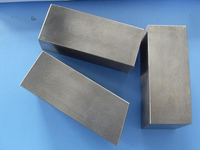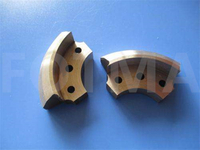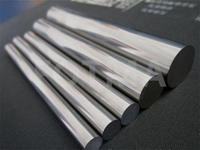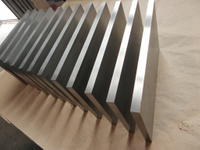Views: 9 Author: Tungsten China Publish Time: 2015-07-01 Origin: TungstenChina
Henri Moissan discovered tungsten carbide in 1893 during a search for method of making artificial diamonds. Charging sugar and tungsten oxide, he melted tungsten sub-carbide in an arc furnace. The carbonized sugar reduced the oxide and carburized the tungsten Moissan recorded that the tungsten carbide was extremely hard, approaching the hardness of diamond and exceeding that of sapphire. It was more than 16x as heavy as water. The material proved to be extremely brittle and seriously limited its industrial use.
Commercial tungsten carbide with 6% cobalt binder was first produced and marketed in Germany in 1926. Production of the same carbide began in the U.S. in 1928 and in Canada in 1930.
At this time, hard carbides consisted of the basic tungsten carbide system with cobalt binders. These carbides exhibited superior performance in the machining of cast iron, nonferrous, and non-metallic materials, but were disappointed when used for the machining of steel.
Most of the subsequent developments in the hard carbides have been modifications of the original patents, principally involving replacement of part or all of the tungsten carbide with other carbides, especially titanium carbide and/or tantalum carbide. This led to the development of the modern multi-carbide cutting tool materials permitting the high speed machining of steel.
A new phenomenon was introduced with the development of the cemented carbides, again making higher speeds possible. Previous cutting tool materials, products of molten metallurgy, depended largely upon heat treatment for their properties and these properties could, in turn, be destroyed by further heat temperatures, these products of molten metallurgy failed.
A different set of conditions exist with the cemented carbides. The hardness of the carbide is greater than the of most other tool materials at room temperature and it has the ability to retain its hardness at elevated temperatures to a greater degree, so that greater speeds can be adequately supported.
Manufacture of Carbide Products
The term “tungsten carbide” describes a comprehensive family of hard carbide compositions used for metal cutting tools, dies of various types, and wear parts. In general, these materials are composed of the carbides of tungsten, titanium, tantalum, or some combination of these, sintered or cemented in a matrix binder, usually cobalt.
Blending: The first operation after reduction of the tungsten metal powder is the milling of tungsten and carbon prior to the carburizing operation. Here, 94 parts by weight of tungsten and six parts by weight of carbon - usually added in the form of lampblack - are blended together in a rotating mixer or ball mill. This operation must be performed under carefully controlled conditions in order to insure optimum dispersion of the carbon in the tungsten. Carbide blending equipment - better known as a ball mill.
In order to provide the necessary strength, a binding agent, usually cobalt is added to the tungsten in powder form and these two are ball milled together for a period of several days, to form a very intimate mixture. Careful control of conditions, including time, must be exercised to obtain a uniform, homogeneous product.
Compacting: The most common compacting method for grade powders involves the use of a die, made to the shape of the eventual product desired. The size of the die must be greater than the final product size to allow for dimensional shrinkage that takes place in the final sintering operation. These dies are expensive, and usually made with tungsten carbide liners. Therefore, sufficient number of the final product (compacts) are required, to justify the expense involved in manufacturing a specific die. Carbide compacting equipment - better known as a pill press4, and various pill pressed carbide parts.
If the quantities are not high, a larger briquette, or billet, may be pressed. This billet may then be cut up (usually after pre-sintering) into smaller units and shaped or preformed to the required configuration, and again, allowance must be made to provide for shrinkage. Ordinarily pressures used in these cold compacting operations are in the neighborhood of 30,000 PSI. Various carbide-preformed parts.
A second compacting method is the hot pressing of grade powders in graphite dies at the sintering temperature. After cooling, the part has attained full hardness. Because the graphite dies are expendable, this system is generally used only when the part to be produced it too large for cold pressing and sintering.
A third compacting method, usually used for large pieces, is isostatic pressing. Powders are placed in a closed, flexible container that is then suspended in a liquid in a closed pressure vessel. Pressure in the liquid is built up to the point where the powders become properly compacted. This system is advantageous for pressing large pieces, because the pressure acting on the powders operates equally from all directions, resulting in a compact of uniform pressed density.
Sintering: A cobalt compact is heated in a hydrogen atmosphere or vacuum furnace in temperatures ranging from 2,500 to 2,900°F, depending on the composition. Both time and temperature are carefully adjusted in combination, to effect optimum control over properties and geometry. The compact will shrink approximately 16% on linear dimensions, or 40% in volume. The exact amount of shrinkage depends on several factors, including particle size of the powders, and the composition of the grade.
Control of the size and shape is most important and is least predictable during the cooling cycle. This is particularly true with those grades of cemented carbides with higher cobalt contents.
With cobalt having a lesser density than tungsten, it occupies a greater part of the volume than would be indicated by the rated cobalt content of the grade. And, because cobalt contents are generally a much higher percentage of the mass in liquid phase, extreme care is required to control and predict with accuracy the magnitude and direction of shrinkage. carbide parts being loaded into a sintering furnace, and a more detailed schematic diagram of the cemented tungsten carbide manufacturing process .
Classification of Carbide Tools
Cemented carbide products are classified into three major categories:
• Wear Grades — used primarily in dies, machine and tool guides, and in everyday items such as line guides on fishing rods and reels. Used anywhere good wear resistance is required.
• Impact Grades — also used for dies, particularly for stamping and forming, and in tools such as mining drill heads.
• Cutting Tool Grades — the cutting tool grades of cemented carbides are divided into two groups, depending on their primary application. If the carbide is intended for use on cast iron that is a nonductile material, it is graded as a cast iron carbide. If it is to be used to cut steel, a ductile material, it is graded as a steel grade carbide.
Cast iron carbides must be more resistant to abrasive wear. Steel carbides require more resistance to cratering and heat. The tool wear characteristics of various metals are different, thereby requiring different tool properties. The high abrasiveness of cast iron causes mainly edge wear to the tool. The long chip of steel, which flows across the tool at normally higher cutting speeds, causes.
content is empty!





